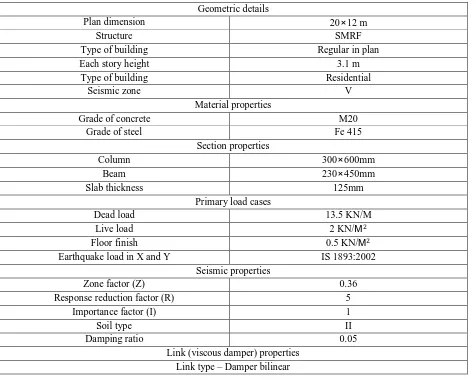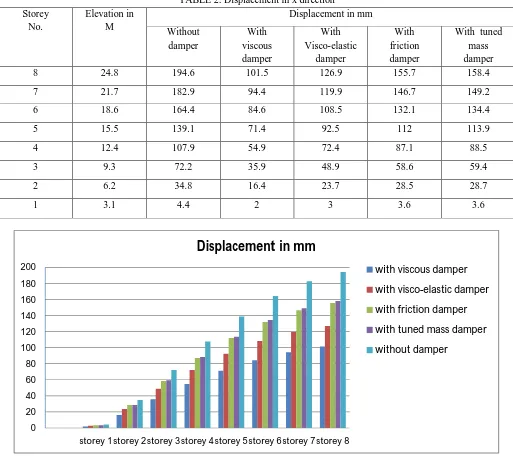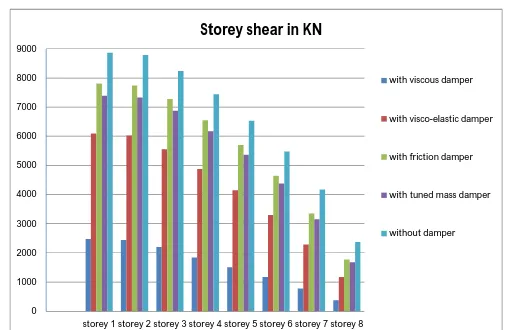5
IV
April 2017
Technology (IJRASET)
Comparative Study of Various Types of Dampers
used for Multi-Story R.C.C. Building
M. S. Landge , Prof. P. K. Joshi
1
M.E. Scholar, 2Associate Professor, Civil Engg., PVPIT (India)
Abstract: dampers are used to resist lateral forces coming on the structure. Dampers are the energy dissipating devices which also resist displacement of rc building during earthquake. These dampers help the structure to reduce the buckling of columns and beams and the stiffness of the structure is increased. At the time of earthquake multi-storey building is damaged and large deformation occurred in multi-storey building. Dampers reduce vibration and deformation of rc building during earthquake. There is lot of various types are used in rc building. This study .deals with selection of suitable type of damper which will be more resistant to earthquake for the selected building.
The dissertation work is concerned with the comparative study of various types of dampers used for multi-storey r.c.c. Building. Response spectrum method is used to analyse seismic behavior of g+7 storey building with and without dampers. In response spectrum method, earthquake load is applied in both x and y direction. For the analysis purpose etabs 2015 software is used by considering seismic zone iv as per is 1893:2002(part 1) code. Results of these analyses are discussed in terms of various parameters such as maximum absolute displacement, absolute acceleration, absolute velocity, storey shear, storey drift. The comparison of these various parameters is done. The structure is analyzed with and without various types of dampers. Results of these analyses are discussed in terms of various parameters such as maximum absolute displacement, absolute acceleration, storey shear, storey drift. The comparison of these various parameters is done. From these comparison it is concluded that maximum absolute displacement, absolute acceleration, storey shear, storey drift values are more in case of rc building without damper as compared to rc building with dampers.
Keywords: viscous dampers, visco-elastic damper, friction damper, tuned mass damper.
I. INTRODUCTION
Earthquake in the simplest terms can be defined as Shaking and vibration at the surface of the earth resulting from underground movement along a fault plane. The vibrations produced by the earthquakes are due to seismic waves. Seismic waves are the most disastrous one. However, modern high rise buildings and tall structures cannot conveniently be geared up with these techniques. The safety and serviceability of any structure is thus endangered with the increasing elevation. As per the standard codes, a structure that can resist the highest earthquake that could possibly occur in that particular area can be called as an earthquake resistant structure. However, the most efficient way of designing earthquake resistant structure would be to minimize the deaths as well as minimize the destruction of functionality of the structural element. The most disastrous thing about earthquake is its unpredictability of time and place of occurrence. These possess a great challenge to the economy and safety of structure. From the past and few present records, the world has experienced number of destroying earthquakes, causing in number of increase the loss of human being due to structural collapse and severe damages to structure. Because of such type of structural damages, during seismic (earthquake) hazards clearly explains that the buildings / structures like residential buildings, public life-line structures, historical structures and industrial structures should be designed to seismic force design and very carefully to overcome from the earthquake hazards. The approach in structural design using seismic response control device is now widely accepted for structure and frequently used in civil engineering field. Structural control concept into a workable technology and such devices are installed in structures.
The Various types of damper are summarized below
A. Viscous Damper
Technology (IJRASET)
Fig: 1 Viscous Damper
B. Visco-Elastic Dampers
Another type of damper is visco-elastic dampers which stretch an elastomer in combination with metal parts. In visco-elastic dampers, the energy is absorbed by utilising controlled shearing of solids.
Fig: 2 Visco-elastic Damper
C. Friction Damper
Friction dampers use metal or other surfaces in friction; and energy is absorbed by surfaces with fiction between them rubbing against each other. Typically a friction damper device consists of several steel plates sliding against each other in opposite directions. The steel plates are separated by shims of friction pad material. The damper dissipates energy by means of friction between the sliding surfaces.
Fig: 3 Friction Damper D. Tuned Mass Damper
Technology (IJRASET)
[image:4.612.250.365.102.234.2]of structures to study the effectiveness of TMDs in reduction of seismic response of structures.
Fig: 4 Tuned mass Damper
II. OBJECTIVE OF PRESENT STUDY
A. To study seismic behavior of selected G+7 R.C.C. building with various types of dampers by using ETABS 2015 software. B. Compare various parameters namely base shear, storey drift, absolute displacement, and the absolute acceleration.
C. Selection of suitable type of damper which will be more resistant to earthquake for the selected building. III. PROBLEM STATEMENT
TABLE 1: Problem statement for analysis Geometric details
Plan dimension 20×12 m
Structure SMRF
Type of building Regular in plan
Each story height 3.1 m
Type of building Residential
Seismic zone V
Material properties
Grade of concrete M20
Grade of steel Fe 415
Section properties
Column 300×600mm
Beam 230×450mm
Slab thickness 125mm
Primary load cases
Dead load 13.5 KN/M
Live load 2 KN/M
Floor finish 0.5 KN/M
Earthquake load in X and Y IS 1893:2002 Seismic properties
Zone factor (Z) 0.36
Response reduction factor (R) 5
Importance factor (I) 1
Soil type II
Damping ratio 0.05
[image:4.612.73.549.351.731.2]Technology (IJRASET)
Mass 1700 Kg.
Weight 0.173 KN
Effective Stiffness 20,000 KN/M
Effective Damping 10,000 KN-S/M
Link (visco-elastic) properties Link type – Damper exponential
Mass 2000 Kg.
Weight 0.203 KN
Effective Stiffness 30,000 KN/M
Effective Damping 10,000 KN-S/M
Link (friction damper) properties Link type – Damper exponential
Mass 2200 Kg.
Weight 0.225 KN
Effective Stiffness 20,000 KN/M
Effective Damping 4,000 KN-S/M
Link (tuned mass damper) properties Link type – Damper bilinear
Mass 2500 Kg.
Weight 0.25 KN
Effective Stiffness 5,000 KN/M
Effective Damping 4,000 KN-S/M
Technology (IJRASET)
IV. RESULT AND DISCUSSIONS
Dampers are used to reduce the seismic effect of the structure which is subjected to the earthquake load. The frames (with and without damper) is modeled according to the properties of the structure which are explained in the work. The models are subjected to analysis for gravity load (i.e., dead and live load) and seismic loads. Dynamic analysis is carried out by response spectrum method according to the Indian Standards codes by using ETABs 2015 software. The seismic behavior of the Reinforced Concrete structure is judged by observing the parameters such as absolute displacement, acceleration, story drift and story shear.
A. Absolute Displacement
[image:6.612.49.562.235.691.2]Displacement is the parameter of maximum importance as it governs the failure pattern of the structure. From this present study, the displacement of the model with and without damper is observed. By providing the damper to the structure we observe that the displacement of the structure is reduced.
TABLE 2: Displacement in x direction Storey
No.
Elevation in M
Displacement in mm
Without damper With viscous damper With Visco-elastic damper With friction damper
With tuned mass damper
8 24.8 194.6 101.5 126.9 155.7 158.4
7 21.7 182.9 94.4 119.9 146.7 149.2
6 18.6 164.4 84.6 108.5 132.1 134.4
5 15.5 139.1 71.4 92.5 112 113.9
4 12.4 107.9 54.9 72.4 87.1 88.5
3 9.3 72.2 35.9 48.9 58.6 59.4
2 6.2 34.8 16.4 23.7 28.5 28.7
1 3.1 4.4 2 3 3.6 3.6
Graph 1: Comparison of displacement in x direction
0 20 40 60 80 100 120 140 160 180 200
storey 1storey 2storey 3storey 4storey 5storey 6storey 7storey 8
Displacement in mm
with viscous damper
with visco-elastic damper
with friction damper
with tuned mass damper
Technology (IJRASET)
TABLE 3: Displacement in y direction Storey
No.
Elevation in m
Displacement in mm
Without damper With viscous damper With Visco-elastic damper With friction damper
With tuned mass damper
8 24.8 256 112.9 151.1 189.1 199.5
7 21.7 242.4 107.9 144.5 179.6 189.7
6 18.6 219.4 99.5 132.7 162.9 172.4
5 15.5 188.1 87.2 115.7 139.9 148.2
4 12.4 149.6 70.8 93.9 111.4 118
3 9.3 104.4 50.2 67.3 78.1 82.7
2 6.2 54 25.9 35.9 41 43
1 3.1 6.3 3.5 4.3 5.2 5.3
Graph 2: Comparison of displacement in y direction
B. Acceleration
Storey acceleration is maximum at top floor when RC building analyses without damper. But when RC building analyses with damper acceleration values changes at each storey.
0 50 100 150 200 250 storey 1 storey 2 storey 3 storey 4 storey 5 storey 6 storey 7 storey 8
Displacement in mm
with viscous damper
with visco-elastic damper
with friction damper
with tuned mass damper
Technology (IJRASET)
TABLE 4: Acceleration in x direction Storey
No.
Elevation in m
Acceleration in mm/sec.
Without damper With viscous damper With Visco-elastic damper With friction damper
With tuned mass damper 8 24.8 6794.96 2664.08 3345.73 5094.24 4817.75
7 21.7 5233.8 2562.13 3123.62 4419.45 4172
6 18.6 4840.62 2487.63 2909.4 3976.68 3768.88
5 15.5 4835.41 2514.91 2674.54 3686.62 3503.62
4 12.4 4774.18 3231.77 2999.26 3716.86 3584.91
3 9.3 4730.18 3425.73 3223.2 3664.18 3561.37
2 6.2 3162.61 2228.4 2351 2397.98 2324.56
1 3.1 468.08 338.14 345.17 362.78 343.1
Graph 3: Comparison of acceleration in x direction
0
1000
2000
3000
4000
5000
6000
7000
storey 1 storey 2 storey 3 storey 4 storey 5 storey 6 storey 7 storey 8Acceleration in mm/sec.²
with viscous damper
with visco-elastic damper
with friction damper
with tuned mass damper
Technology (IJRASET)
TABLE 5: Acceleration in y direction Storey
No.
Elevation in m
Acceleration in mm/sec.
Without damper
With viscous damper
With Visco-elastic
damper
With friction damper
With tuned mass damper 8 24.8 5865.08 1911.61 2238.16 3877.61 3505.31
7 21.7 4515.41 1939.9 2143.43 3402.46 3120.57
6 18.6 4063.8 1896.57 1923.76 2930.69 2682.62
5 15.5 4323.43 2079.22 1914.34 2827.96 2611
4 12.4 4655.33 2463.94 2183.79 3070.69 2888.91
3 9.3 4578.91 3247.7 3023.85 3306.1 3164.68
2 6.2 3926.83 3602.76 3467.87 3286.87 3212.38
1 3.1 595.61 697.76 532.41 534.46 497.92
Graph 4: Comparison of acceleration in y direction
C. Storey Drift
As the number of story increases in the structure, the drift is the common factor for multi-storey building. The variance between the lateral displacements of two adjacent floors of the structure is defined as the story drift. The structure which is modeled and analyzed by dynamic analysis i.e., response spectrum method. The values of the storey drift of the structure are noted According to IS 1893(Part 1):2002 clause 7.11.1 Storey drifts limitations are explained that the Storey drifts in any storey due to the minimum specified design lateral force, with partial load factor of 1.0 shall not exceed 0.004 times the storey height.
0 1000 2000 3000 4000 5000 6000
storey 1 storey 2 storey 3 storey 4 storey 5 storey 6 storey 7 storey 8
Acceleration in mm/sec.²
with viscous damper
with visco-elastic damper
with friction damper
with tuned mass damper
Technology (IJRASET)
TABLE 6: Storey drift in x direction Storey
No.
Elevation in m
Storey drift in mm Without
damper
With viscous damper
With Visco-elastic damper
With friction damper
With tuned mass damper
8 24.8 0.004484 0.002525 0.002452 0.003246 0.00331 7 21.7 0.00691 0.003543 0.003993 0.005178 0.005289
6 18.6 0.00903 0.004702 0.005543 0.006996 0.00716 5 15.5 0.010757 0.005765 0.006881 0.008489 0.008705
4 12.4 0.012055 0.006546 0.00793 0.009609 0.009854 3 9.3 0.012505 0.006625 0.008408 0.010041 0.010275 2 6.2 0.01016 0.004922 0.006923 0.008291 0.008392 1 3.1 0.003354 0.001622 0.002298 0.00280 0.00285
Graph 5: Comparison of storey drift in x direction
0 0.002 0.004 0.006 0.008 0.01 0.012
storey 1 storey 2 storey 3 storey 4 storey 5 storey 6 storey 7 storey 8
Storey drift in mm
with viscous damper
with visco- elastic damper
with friction damper
with tuned mass damper
Technology (IJRASET)
TABLE 7: Storey drift in y direction Storey
No.
Elevation in m
Storey drift in mm
Without damper
With viscous damper
With Visco-elastic damper
With friction damper
With tuned mass damper
8 24.8 0.005793 0.001855 0.002463 0.003517 0.003658
7 21.7 0.009391 0.003111 0.0043840 0.006086 0.006386
6 18.6 0.01197 0.00438 0.006154 0.00824 0.008707
5 15.5 0.013855 0.005764 0.007726 0.009952 0.010557
4 12.4 0.015517 0.007072 0.009193 0.011351 0.012095
3 9.3 0.016948 0.008141 0.010604 0.01246 0.013307
2 6.2 0.015887 0.007476 0.010543 0.011981 0.012628
1 3.1 0.004862 0.002771 0.00328 0.004074 0.003984
Graph 6: Comparison of storey drift in y direction
0 0.002 0.004 0.006 0.008 0.01 0.012 0.014 0.016 0.018
storey 1 storey 2 storey 3 storey 4 storey 5 storey 6 storey 7 storey 8
Storey drift in mm
with viscous damper
with visco- elastic damper
with friction damper
with tuned mass damper
Technology (IJRASET)
D. Storey shear
[image:12.612.50.557.392.722.2]The story shear is the shear value obtained from the sum of design lateral forces at the levels above the story consideration of the structure. The story shear at bottom stories will be maximum and will be minimum at the top stories. The shear values of the both models are below in the table.
TABLE 8: Storey shear in x direction Storey
No.
Elevation in m
Storey shear in KN
Without damper
With viscous damper
With Visco-elastic
damper
With friction damper
With tuned mass damper 8 24.8 2371.54 383.45 1168.24 1775.37 1677.33
7 21.7 4177.78 787.0 2290.82 3348.5 3158.006
6 18.6 5476.69 1168.94 3299.69 4644.22 4377.87
5 15.5 6542.53 1510.18 4151.18 5698.78 5369.89
4 12.4 7445.72 1848.35 4880.35 6558.076 6180.44
3 9.3 8241.81 2203.14 5561.63 7280.31 6875.48
2 6.2 8787.07 2443.26 6028.52 7744.84 7329.73
1 3.1 8867.06 2477.06 6096.33 7812.20 7395.066
Graph 7 : Comparison of storey shear in x direction
0 1000 2000 3000 4000 5000 6000 7000 8000 9000
storey 1 storey 2 storey 3 storey 4 storey 5 storey 6 storey 7 storey 8
Storey shear in KN
with viscous damper
with visco-elastic damper
with friction damper
with tuned mass damper
Technology (IJRASET)
TABLE 9: Storey shear in y direction Storey
No.
Elevation in m
Storey shear in KN
Without damper
With viscous damper
With Visco-elastic damper
With friction damper
With tuned mass damper 8 24.8 2037.81 276.46 779.85 1335.93 1217.1
7 21.7 3460.28 583.76 1552.78 2564.01 2337.5
6 18.6 4401.27 871.59 2220.47 3551.23 3236.27
5 15.5 5087.48 1164.40 2814.56 4336.78 3951.60
4 12.4 5723.27 1477 3385.98 5005.18 4567.28
3 9.3 6384.26 1815.4 4004.85 5601.26 5131.24
2 6.2 6933.65 2157.38 4695.78 6111.22 5638.515
1 3.1 7020.43 2221.92 4810.88 6169.9 5722
Graph 8: Comparison of storey shear in y direction
0 1000 2000 3000 4000 5000 6000 7000
storey 1 storey 2 storey 3 storey 4 storey 5 storey 6 storey 7 storey 8
Storey shear in KN
with viscous damper
with visco-elastic damper
with friction damper
with tuned mass damper
Technology (IJRASET)
V. CONCLUSION
After carrying out results by using ETABS 2015 software for multi-storey building, various parameters like absolute displacement, acceleration, storey drift, base shear are compared. Following conclusions are made.
A. By comparing the results (Graph no.1 and 2) it is concluded that lateral deflection for RC building with viscous damper as compared to other dampers is minimum.
B. By comparing the results (Graph no.3 and 4) it is concluded that absolute acceleration values for RC building with viscous damper are less
C. By comparing the results (Graph no.5 and 6) it is also concluded that storey drift values for RC building with viscous damper as compared to other dampers are minimum.
D. Base shear is maximum at the base and by comparing results (Graph no.7 and 8) It is observed that base shear values for RC building with viscous damper as compared to other damper are minimum.
E. From above it can be concluded that the viscous damper devices perform a vital role in reducing and controlling the seismic response of the structure as compared other types of dampers.
REFERENCES
[1] IS 13920: 1993 Ductile detailing of reinforced concrete structures subjected to seismic forces. [2] IS 1893 (Part 1): 2002 Criteria for earthquake resistant design of structures.
[3] Mohsen Kargahi and Chukwuma G. Ekwueme, " Optimization of viscous damper properties for reduction of seismic risk in concrete buildings’’. 13th World Conference on Earthquake Engineering Vancouver, B.C. Canada August 1-6, 2004 Paper No. 1027.
[4] Yukihiro Tokuda and Kenzo Taga, "A case of structural design in which viscous dampers are used to enhance earthquake resisting performance of building’’ the 14 World Conference on Earthquake Engineering October 12-17, 2008.
[5] Nitendra G. Mahajan and D. B. Raijiwala, " Seismic responce control of a building installed with passive dampers’’ International Journal of Advanced Engineering Technology E-ISSN 0976-3945 IJAET/Vol.II/ Issue III/July-September, 2011.
[6] Thakur V.M., Pachpor P.D., " Seismic Analysis of Multistoried Building with TMD (Tuned Mass Damper) ‘’ International Journal of Engineering Research and Applications (IJERA) ISSN: 2248-9622 www.ijera.com Vol. 2, Issue 1, Jan-Feb. 2012, pp. 319-326.
[7] Kasai, K., Weng, D.G. and Wada, A. (2012), " Unified Seismic Design Methodology for RC Frame Structures Using Viscous, Viscoelastic and Steel Dampers’’. 15th World Conference on earthquake Engineering. Lisbon, Portugal.
[8] K. KRISHNE GOWDA and K. K. KIRAN, "Earthquake resistance of structures using dampers’’. International Journal of Advanced Structures and Geotechnical Engineering ISSN 2319-5347, Vol. 02, No. 01, January 2013.
[9] Vajreshwari Umachagi, Katta Venkataramana, G. R. Reddy, Rajeev Verma, "Application of dampers for vibration control of structures’’. IJRET: International Journal of Research in Engineering and Technology eISSN: 2319-1163 | pISSN: 2321-7308 IC-RICE Conference Issue | Nov-2013.


